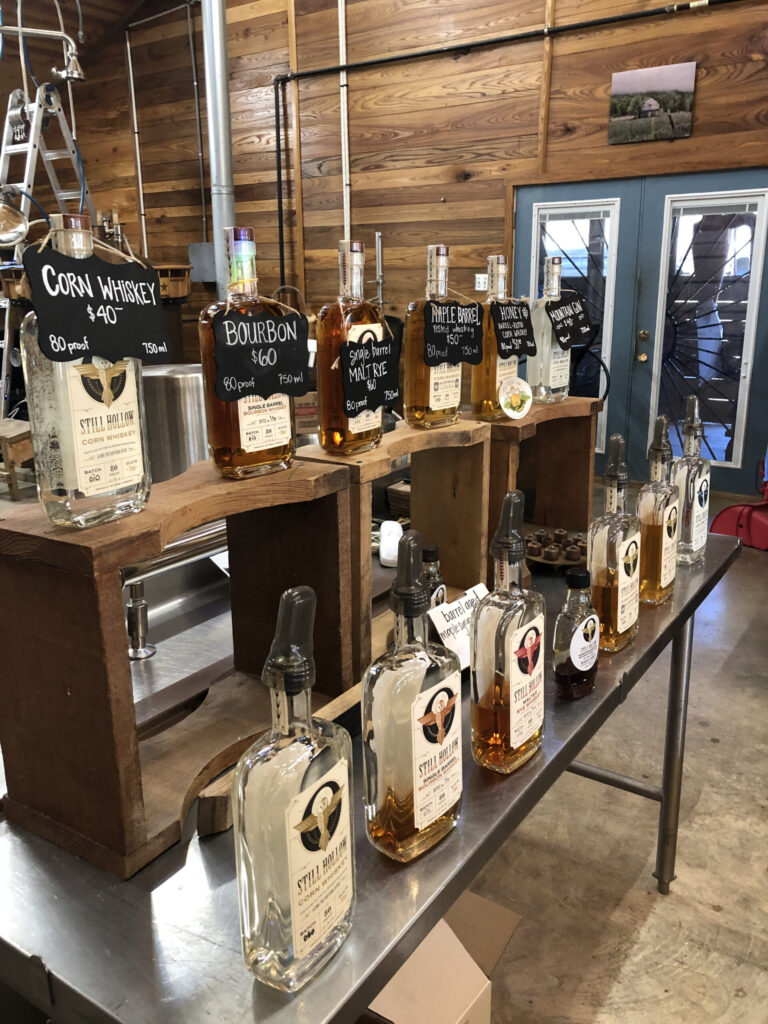Moonshine has long been a symbol of rebel, anti-establishment freedom, making it one of the most intoxicating facets of Appalachian folklore. Historically, moonshine was stigmatized—viewed as a shameful part of life in Appalachia and the “suicide” of hillbillies. However, over the years, it has become valued as cultural experience. Legal distilleries have opened throughout the state, offering locals and tourists the opportunity to taste moonshine without fear of law enforcement. While it was once a something treated with stealth, moonshine is now openly spoken about and even shared by West Virginia Senator Joe Manchin in the nation’s capital.
Moonshining came about as a result of liquor taxation, prohibition, and as a component of subsistence living. I incorrectly thought that moonshine was a particular type of liquor, and although there are traditional types, moonshine is illegally produced liquor. To avoid being discovered, illegal whiskey was produced by the light of the moon—hence the word “moonshine”.
Moonshine has been around for centuries. For people who already lived off the land, making their own liquor was natural. Moonshining became an industry as people found that they could make more money selling liquor than they could from the corn used to produce it. Americans have a long tradition of fighting or disregarding government regulations of liquor. Congress imposed its first whiskey taxes in 1791, leading to the Whiskey Rebellion of 1794. In the 1920s, prohibition created riskier but more profitable conditions for distillers. Although people had been illegally making and selling liquor long before, distillers became true “moonshiners”—operating under the guise of darkness—during prohibition.
Historically, moonshining was a male-dominated industry. Because the production process was considered dangerous, distillers were mostly male. However, women and Black people were oftentimes bootleggers. Women were less likely suspects, making them well suited for look-out positions and for running the business side of the operation. There are documented examples of Black and white female distillers and bootleggers in Appalachia and beyond. They were able to evade law enforcement and financially support themselves (albeit illegally) during periods when women were generally expected to remain in the home and rarely had career prospects comparable to men.

Over the weekend, I visited Still Hollow Distillery near Harman, West Virginia to learn more about the process of making moonshine. Traditionally, moonshine was illegally distilled corn whiskey, but the ingredients of the liquor can vary and have changed over time. It was typically clear colored and unaged (don’t wanna keep the illicit goods sitting around longer than you have to) whiskey produced in a copper still. Still Hollow has clear corn whiskeys and a variety of aged whiskeys which are darker colored. Because they pay taxes on their liquor, Still Holllow is able to legally distill using moonshiners’ traditional methods.

As I pulled into the farm, I was greeted by a few cows basking in the sun. The main building, which was constructed using only Randolph County wood, quickly came into view. Both elements of this bucolic scene—Randolph County sourced wood and the cows—speak to the philosophy of Still Hollow. The company’s commitment to sustainability and their community became obvious to me as Tyler, the Still Hollow employee doing my tasting and tour, told me about the history of Still Hollow, their methodology, and their farm’s operations.
They work with maple syrup and honey farms to produce locally flavored variations of their whiskeys. The cows who grazed out front are part of the farm’s ecology system, providing fertilizer and meat. Still Hollow also produces small batches of whiskey, which lends itself to less waste and a greater ability to utilize local but potentially more scarce or seasonal ingredients. The use of local flavors like honey, the farm’s spring water, and the exposure to mountain air can help create a unique tasting liquor (although an untrained palette may not be able to pick up differences).
Still Hollow offers free tastings, which I participated in to learn more about the production process. Moonshine is typically made from a corn mash. Inside the still, the corn mash undergoes fermentation, which is when yeast breaks down sugar and produces alcohol. Distillation involves evaporating the alcohol and then collecting and condensing the steam back into liquid form. Despite its high alcohol proof, every liquor I tried was smooth. Tyler explained how each bottle was made—whether it was barrel aged or infused with other flavors. I don’t consider myself to be very perceptive of differences in liquor, but his explanations made it easier for me to understand what I was tasting. My favorite was the clear corn whiskey.

Today, distilling at home is still illegal; however, distilleries like Still Hollow have popped up across West Virginia and offer a way to drink moonshine without fear of ending up behind bars. Moonshine has become part of the cultural experience of West Virginia, posing potential opportunities for the state’s tourism. Food and drinks are important facets of culture that can give insight into how people live, what resources they have, and what they value. Moonshine tells a story of subsistence lifestyle, the flavors of the mountains, and mountaineers’ independent and rebellious spirit.


Hannah, if you haven’t seen my film “Music of Heaven,” check it out. An old moonshiner goes through the whole process on there. Nice piece about Still Hollow!